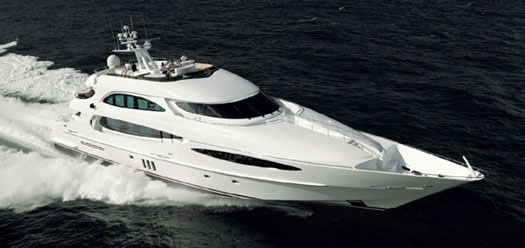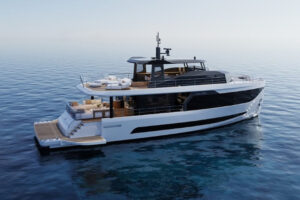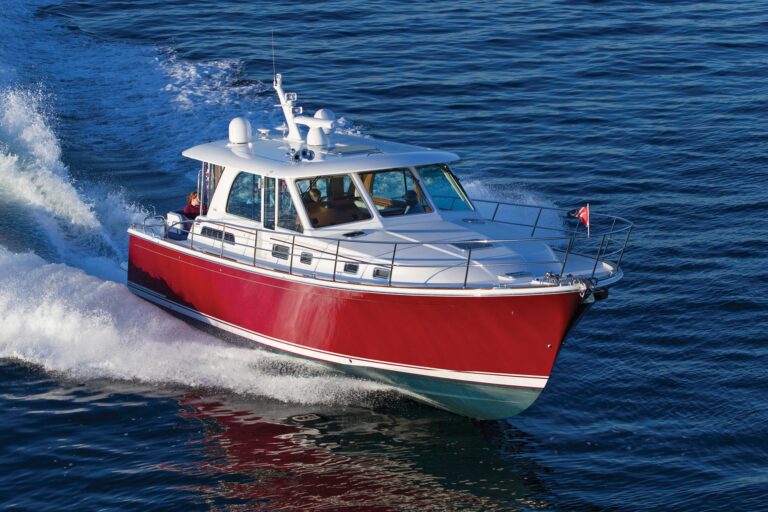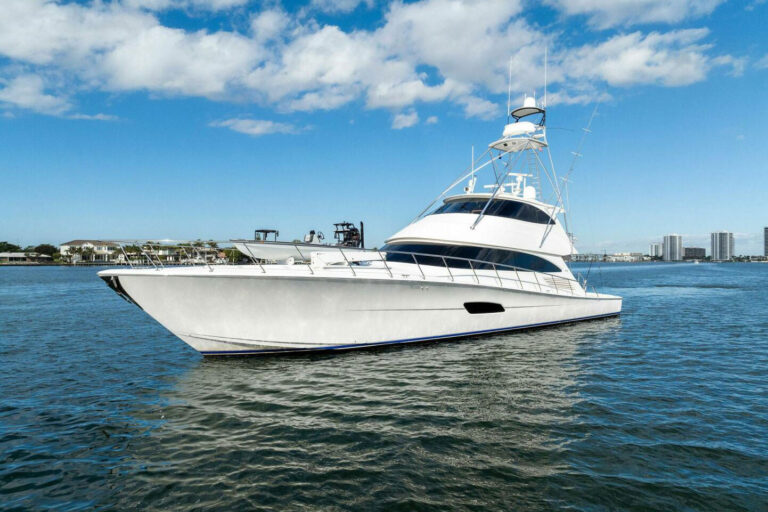
Luxury and performance coexist on /The World Is Not Enough/ thanks to an alustar aluminum hull that saves weight.
Lolling about the plush skylounge of The World Is Not Enough talking with John Staluppi about speed in megayachts, I am almost persuaded that, for him, the main attraction is one of convenience. He cites several examples of passages you could make in a day that would otherwise require an overnight effort on the part of your crew, not to mention the inconvenience inflicted on those of your land-based guests who might be meeting the boat at the next destination.
I found myself nodding along. Yes. Better to flog those 20,600 horses than risk a night at the Me-Too Motel.
But I wasn’t disagreeing, either. There’s a mindset that comes along with the great experimenters, the patrons of excellence, that should not be tallied with a pocket calculator and P&L. The Pope may have grumped about Michelangelo’s invoices, but he didn’t replace him, either. In Staluppi’s case, the obsession with superyacht speed justifies all.
So where did it start? Wondering which influence came first, I asked him about his early yachting experiences: Was it luxury or performance? And he told me about a Cigarette he owned and loved to drive, and about racing his long-time friend and business associate, John Rosatti, out to the Jersey canyons. An experience most of us can understand, akin to seeing who can get from the high school parking lot to the burger hut fastest.
It doesn’t matter what he’s driving, it’s got to be fast and he’s got to be first. The realization explained a lot. It almost explained the Millennium 140, a 165-ton sea-skimming missile finished and equipped to yacht standards that has already achieved speeds in excess of 65 knots during its sea trials. That’s epic speed for a megayacht, the kind that collapses distance and time into Day-Runner terms. Her four engines, with that combined output of 20,600 horses, can drive this yacht at 45 knots without straining-indeed, when loafing along at 50 percent load-as they did during the photo session for this story.
Yet this is not enough for Staluppi. The design brief is for 70 knots and so the fine-tuning is far from done. There is no mistaking the resolve in Staluppi’s eyes. Not for nothing is this yacht named The World Is Not Enough.
Blame it on the King of Spain. When Palmer Johnson launched the 100-foot, Don Shead-designed Fortuna in 1979 for Juan Carlos, the new royal yacht established a 52-knot record that lit the imagination of megayacht builders around the world. Prior to that time, top speeds in the 20-plus knot range were typical. The record stood until 1988, when it was eclipsed by Octopussy, a 132-foot Diaship/Heesen-built design from the mind and drawing board of Dutch naval architect Frank Mulder for Staluppi and Rosatti. With triple 3,500 hp MTU diesels and KaMeWa 63 water jets, it topped out at 53.17 knots, a speed that would stand until June, 1992, when Mulder’s next design, Moonraker, would turn in a top speed of 66.7 knots. Fast yacht development seemed to have peaked at that point, until Juan Carlos launched Fortuna III in 2000, and was credited with a 68-knot record. And the flag was dropped.
The World Is Not Enough is a Millennium 140 trideck luxury high-speed yacht with accommodations for 10, designed by Frank Mulder for Staluppi and Rosatti and built at their own yard in Hardinveld-Glessendam, Holland under the auspices of their custom yacht company, Millennium Super Yachts, founded in 1998. The hull shape is a derivative of previous fast yacht designs from Mulder, whose experience designing high-speed patrol boats in the early 1980s served him well in this arena. Hitting weight, speed, and stability targets is paramount to Mulder and his design staff, and these were established early in the process to guide all design and building phases.
The design brief describes the hull as a modified full planing shape with a deep-V entry. Stabilization and trim are provided by oversized trim tabs, large area sections of the afterbody, driven by a Quantum hydraulic control system. These tabs also double as stabilizers at low to moderate speeds. The welded hull is fabricated with Alustar, an advanced aluminum from Europe’s Corus Group, selected for its strength and its weight savings-20 percent less than typical marine aluminum alloys.
Propulsion is a unique combination of twin 5,300 hp Paxman diesel engines as outside, or “wing” engines and twin 5,000 hp Lycoming jet turbines linked through a single custom gearbox, which function as booster rockets. The wing engines are linked to steerable Lips water jets, while the turbines are connected to a single, fixed Lips water jet with no reverse capacity. This configuration allows the yacht to operate on a single diesel for efficiency and slow-speed, long-distance passages, or on both diesels for typical operating situations and speeds to approximately 40 knots. The captain also has the option of adding output from one turbine, increasing speeds to the mid-50-knot range, or spooling up both turbines to achieve top speeds of 70 knots or more when conditions are optimal. Range is predicated on speed, ranging from 750 to 3,000 nautical miles.
Automatic sliding doors part as you enter the saloon from the aft deck, where a marble foyer with a compass rose inlay and a pair of Erté statuettes on pedestals set the décor level at Art Nouveau, as interpreted for the modern age by well-known London designer Evan Marshall. Dark walnut burl wood is used extensively, combined with contrasting light panels of fabric and carpet, all selectively lit by fiber-optic spots or large side windows. Twin armchairs and custom couches flank a central cocktail table, creating a feeling of formality and luxury, emphasized by an ornate bulkhead that sets them apart from the forward dining area. A home-theater system is housed in the side lockers.
A custom walnut burl table with gold and mahogany serpentine rope inlays anchors the large dining area, and is surrounded by 10 large armchairs for guests. A marble-topped sideboard occupies the forward face of the bulkhead separating the dining and saloon areas, along with a matching marble-topped brace along the sides. Versace crystal and china adorn the table, along with International Silver sterling, for formal meals. Like the foyer leading to the saloon, the dining room also displays a stunning marble floor-quite a feat in a yacht meant to operate at 70-plus knots. John Schmiemann, Staluppi’s project manager and my expert guide during a walk-through of the yacht, told me that in every instance where substantial materials are present, they are bonded to lightweight yet rigid substrates like Nomex honeycomb. That’s how luxury and performance coexist aboard The World Is Not Enough.
Leaving the dining room, you can go forward along the starboard side walkway, past the galley to the master stateroom. Or you can use the spiral stairway with its cantilevered carbon fiber steps and gold-accented stainless steel handrail to go up to the skylounge and pilothouse bridge-descend to the accommodations on the lower deck. A quick peek in the galley reveals a large, U-shaped food preparation area replete with storage cabinets, stainless steel appliances and backsplashes, Amtico tile floors and granite countertops. Two Miele ovens, a six-burner Miele range with commercial hood, and Sub-Zero refrigerators and freezers are key features. Cream-colored Ultraleather upholstery graces the adjacent country kitchen with seating for eight.
The master stateroom is not quite maximum beam width, with a king-size bed on the centerline facing the aft bulkhead and home-theater system. The desk to starboard provides generous space to handle business affairs on the fly, and there’s a comfortable settee to port next to the vanity. Doors on either side of the headboard lead forward through large walk-in closets, which in turn lead to the master bath. Honey-colored onyx floors and countertops provide the visual drama, with separate water closets forward on either side of the marble Jacuzzi tub.
Guest accommodations on the lower deck all radiate off a central foyer, which is equipped with lockers containing a linen closet, a Miele washer and dryer, even a refrigerator for drinks. Two mirror-image staterooms forward feature twin beds and private access to en suite bathrooms. The VIP stateroom and a double guest stateroom are located in the widest portion of the hull. Both feature three massive windows, which should provide wonderful views of surrounding waters. Both also have individual entertainment systems linked to the same satellite TV system that serves other centers aboard. Marble floors are found in all bathrooms on this level, and the décor continues in the rich walnut burl and light fabrics theme of the main deck.
At the top of the spiral stairs, the skylounge is blessed with numerous windows for a marvelously elevated view. A curved full-service bar with backlit glass top is very well-equipped with a 24-bottle wine cooler, refrigerator, icemaker, and espresso machine. Erté flutes in a dedicated cabinet invite spontaneous celebration. A home-theater system is concealed in the aft bulkhead cabinetry, while a 42-inch plasma TV on a lift stores in the portside cabinet. A day head finished in black onyx is set to starboard; like all the other head compartments, it features a Rolex sink and Serdaneli fixtures.
Custom, double-wide Pompanette observer seats flank the central captain’s helm seat, which has operation controls set in the armrests. The forward pilothouse is dominated by a massive five-screen glass panel: an Electronic Charting Display and Information System (ECDIS), two radars of different ranges, closed circuit TV and a general navigation and operation screen. Behind the helm seats, there is seating for six guests on the leather settee behind a granite table. The settee, raised up two steps from the pilothouse deck level, gives guests and owners excellent views out forward and side windows.
Sundeck access is via a portside stairway from the skylounge aft deck. On the centerline far forward is a complete helm with three monitors and three custom Pompanette swivel chairs. Large settees both port and starboard provide seating for a crowd, while the Corian-topped full-service bar aft and to port can handle the needs of guests rendered dry-throated by the vessel’s speed.
As this issue goes to press, plans are under way to mount an assault on the speed record. Breaking it will be icing on the cake for John Staluppi, John Rosatti and Frank Mulder, but you have the feeling that won’t be the end of it. When your yacht is called The World Is Not Enough, there’s always another horizon.
Contact: Millennium Superyachts, (561) 721-4100; www.millenniumsuperyachts.com.








